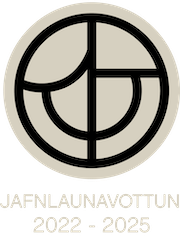Erfðamengjastofnar samlífisfléttu við breytilegar aðstæður - verkefni lokið
Fréttatilkynning verkefnisstjóra
Í verkefninu var tjáning einstakra gena sem tengjast streitu eða álagi, bæði meðal flétta nærri sjó og inn til landsins sérstaklega skoðuð.
Lýsing á verkefni, niðurstöður og áhrif
Eitt áhugaverðasta viðfangsefni líffræðinnar er að skilja
hvernig lífverur bregðast við breyttum aðstæðum, ekki síst vegna hnattrænnar
hlýnunar. Við höfum rannsakað sérstaklega hjá sambýlislífverunni himnuskóf
(Peltigera membranacea), bæði hjá svepphlutanum og ljósbýlingnum, sem er
blágrænbakterían Nostoc. Ein leið til að fást við breyttar aðstæður er
sveigjanleiki í genatjáningu, sem leiða til lífeðlisfræðilegra breyting í takt
við breyttar aðstæður. Við skoðuðum sérstaklega tjáningu einstakra gena sem
tengjast streitu eða álagi, bæði meðal flétta nærri sjó og inn til landsins. Erfðabreytileiki
í einstökum bösum var einnig skoðaður til að meta skiptingu í stofna og
flutning á milli svæða, svo og til að meta hvort og hvernig sambýlislífverurnar
tvær parast saman.
Rannsóknin sýndi að svepphlutinn og ljósbýlingurinn bregðast ekki eins við hita, blágrænbakterían sýnir streituviðbrögð við lægri hita en sveppurinn. Þá sýndu himnuskófir meiri streituviðbrögð eftir því sem þær voru lengra frá sjó. Þá kom í ljós að töluvert genaflæði er á milli svæða, en það bendir til mikillar hæfni við að aðlagast breyttum aðstæðum, svo framarlega sem úrkoma minnkar ekki mikið. Loks styður rannsóknin þá tilgátu að sambýlið myndist oft við það að sveppgró spíri og taki saman við Nostoc blágrænbakteríu sem er þegar á svæðinu, fremur en að einingar með bæði sveppi og ljósbýlingi dreifist langar leiðir.
English
Description of project, results and impact
One of the challenges in biology is to understand the
tolerance of species to changed environmental conditions in the context of
global climatic change. We addressed this important issue using the example of
the lichen fungus Peltigera membranacea and its cyanobacterial photobiont
Nostoc sp. Tolerance can be achieved by flexibility in gene expression,
enabling a physiological response to changed conditions. We studied gene
expression of stress-related genes along a coastal-inland environmental
gradient using a qPCR approach. Moreover, using high-resolution SNP data from
RAD sequencing, we investigated population subdivision and migration between
sites, and assessed the mode of symbiont transfer in P. membranacea.
Our analyses showed that the lichen fungus and its cyanobacterial photobiont respond differently to high temperature, with the cyanobiont developing heat shock at a lower temperature than the fungus. Moreover, the degree of stress response varied along an environmental gradient from coastal to inland sites, indicating that populations are differentially adapted to stress conditions. We found that populations are effectively connected by gene flow, thus the species will most likely be able to colonize new sites, as long as the climate does not get drier. In P. membranacea, the symbiosis is horizontally transferred, so a germinating fungal ascospore must associate with a local Nostoc strain to establish a lichen. The results will be used to develop suitable strategies for the conservation of lichens in the face of global climatic changes.
List of project outputs
Reports: Annual project report, 2014, 2015
Publications and manuscripts:
Fernandez-Mendoza, Westfall, Guðmundsson, Andrésson, Resl and Werth (in prep.) Climate as a driver of population structure in the lichenized fungus Peltigera membranacea in Iceland.
Fernandez-Mendoza, Westfall, Guðmundsson, Andrésson and Werth (in prep.) Cyanobiont diversity in Icelandic populations of the lichenized fungus Peltigera membranacea.
Steinhäuser SS, Andrésson ÓS, Pálsson A, Werth S (2016) Fungal and cyanobacterial gene expression in a lichen symbiosis: Effect of temperature and location. Fungal Biology 120, 1194–1208. Available on author’s personal website
Werth S, Reynisdóttir S, Guðmundsson H, Andrésson ÓS (2016) A fast and inexpensive high-throughput protocol for isolating high molecular weight genomic DNA from lichens. Herzogia 29, 610-616. Available on author’s personal website
Werth S, Miao VPW, Jónsson ZO, Andrésson ÓS (2015) High-throughput sequencing in studies of lichen population biology. In: Recent Advances in Lichenology. Modern Methods and Approaches in Lichen Systematics and Culture Techniques (eds. Upreti DK, Divakar PK, Shukla V, Bajpai R), pp. 61-94. Springer.
Heiti verkefnis:
Erfðamengjastofnar samlífisfléttu við breytilegar aðstæður / Population
genomics of a lichen symbiosis along climatic gradients
Verkefnisstjóri: Silke Werth, Háskóla Íslands
Tegund styrks: Verkefnisstyrkur
Styrkár: 2014-2016
Fjárhæð styrks: 28,287 millj. kr. alls
Tilvísunarnúmer Rannís: 141102


